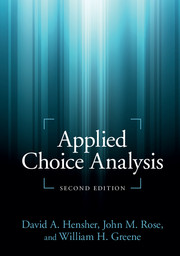Book contents
- Frontmatter
- Contents
- List of Figures
- List of Tables
- Preface
- Part I Getting started
- Part II Software and data
- Part III The suite of choice models
- 11 Getting started modeling: the workhorse – multinomial logit
- 12 Handling unlabeled discrete choice data
- 13 Getting more from your model
- 14 Nested logit estimation
- 15 Mixed logit estimation
- 16 Latent class models
- 17 Binary choice models
- 18 Ordered choices
- 19 Combining sources of data
- Part IV Advanced topics
- Select glossary
- References
- Index
13 - Getting more from your model
from Part III - The suite of choice models
Published online by Cambridge University Press: 05 June 2015
- Frontmatter
- Contents
- List of Figures
- List of Tables
- Preface
- Part I Getting started
- Part II Software and data
- Part III The suite of choice models
- 11 Getting started modeling: the workhorse – multinomial logit
- 12 Handling unlabeled discrete choice data
- 13 Getting more from your model
- 14 Nested logit estimation
- 15 Mixed logit estimation
- 16 Latent class models
- 17 Binary choice models
- 18 Ordered choices
- 19 Combining sources of data
- Part IV Advanced topics
- Select glossary
- References
- Index
Summary
Where facts are few, experts are many.
(Donald R. Gannon)Introduction
In Chapter 11 we presented the standard output generated by Nlogit for the multinomial logit (MNL) choice model. By the addition of supplementary commands to the basic command syntax, the analyst is able to generate further output to aid in an understanding of choice. We present some of these additional commands now. As before, we demonstrate how the command syntax should appear and detail line by line how to interpret the output. The revealed preference (RP) data in the North West travel choice data set is used to illustrate the set of commands and outputs.
The entire command set up and model output is given up front to make it easy for the reader to see at a glance the commands that are used in this chapter. The command set up has two choice models; the first is the MNL model estimated to obtain the standard set of parameter estimates as well as useful additional outputs such as elasticities, partial (or marginal effects) and prediction success; the second MNL model uses the parameter estimates from the first model to undertake “what if” analysis using ;simulation and ;scenario, that involves selecting the relevant alternatives and attributes you want to change to predict the absolute and relative change in the choice shares. Arc elasticities can be inferred from the scenario analysis, since it provides before and after choice shares associated with before and after attribute levels.
- Type
- Chapter
- Information
- Applied Choice Analysis , pp. 492 - 559Publisher: Cambridge University PressPrint publication year: 2015



